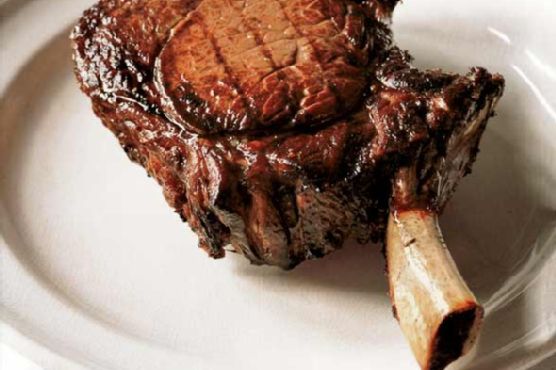Bone-In Rib Eye Steaks with Caramelized Shallots
Bone-In Rib Eye Steaks with Caramelized Shallots could be just the gluten free and ketogenic recipe you've been looking for. One serving contains 975 calories, 72g of protein, and 72g of fat. This recipe serves 4 and costs $8.35 per serving. 78 people were glad they tried this recipe. valentin day will be even more special with this recipe. From preparation to the plate, this recipe takes roughly 45 minutes. A few people really liked this main course. Head to the store and pick up shallots, vegetable oil, sea salt, and a few other things to make it today. It is brought to you by Leites Culinaria. Overall, this recipe earns a super spoonacular score of 90%. Similar recipes are Rib-Eye, T-Bone, and Strip Steaks Cut Over One Inch, Surf and Turf Rib-Eye Crostini with Gorgonzola Mousse and Caramelized Bourbon Shallots, and Tagliatan Of Bone-in Rib-eye With Arugula.
Servings: 4
Preparation duration: 45 minutes
Ingredients:
2 bay leaves
3 1/2 tablespoons butter
Salt and freshly ground pepper
Flaked sea salt
12 large shallots
2 1 1/2 pound côte de boeuf, bone-in rib eye, or big cowboy steaks
1 fresh thyme sprig
1 cup beef or veal stock
1/4 cup vegetable oil
Equipment:
frying pan
broiler pan
grill pan
oven
Cooking instruction summary:
1. Heat the oil in a frying pan, add the whole shallots, and color them over high heat. Once colored, drain off and throw away the oil. Add the butter, bay leaves, thyme, and some salt to the pan. Cook for about 5 minutes, turning and shaking the shallots; try not to burn the butter.2. Add enough stock just to cover the bottom of the pan and let the liquid bubble away before adding any more; the sauce will reduce and become sticky while cooking the shallots at the same time. Continue until the shallots are very soft and have a thick buttery and beefy glaze.3. Meanwhile, heat a ridged cast-iron grill pan or broiler pan until very hot (about 10 minutes). Preheat the oven to 400°F (200°C).4. Season the rib eye steaks well with salt and pepper and score the fat a little. Place the rib eyes fat-side down in the grill pan. The fat will start to melt and this is what is going to flavor the outside of the meat. Once the fat starts to char, lay the steaks onto one side. Cook for 4 minutes.5. Turn the rib eyes over and cook the other side for 4 minutes. Turn over again, but also rotate the steaks 180 degrees, then cook for 2 minutes longer. Flip the rib eyes over again, rotating as before.6. Place the pan in the oven to finish cooking for 4 minutes for a medium-rare steak. Let them rest for 5 minutes before serving them whole, with carving done at the table.
Step by step:
1. Heat the oil in a frying pan, add the whole shallots, and color them over high heat. Once colored, drain off and throw away the oil.
2. Add the butter, bay leaves, thyme, and some salt to the pan. Cook for about 5 minutes, turning and shaking the shallots; try not to burn the butter.
3. Add enough stock just to cover the bottom of the pan and let the liquid bubble away before adding any more; the sauce will reduce and become sticky while cooking the shallots at the same time. Continue until the shallots are very soft and have a thick buttery and beefy glaze.
4. Meanwhile, heat a ridged cast-iron grill pan or broiler pan until very hot (about 10 minutes). Preheat the oven to 400°F (200°C).
5. Season the rib eye steaks well with salt and pepper and score the fat a little.
6. Place the rib eyes fat-side down in the grill pan. The fat will start to melt and this is what is going to flavor the outside of the meat. Once the fat starts to char, lay the steaks onto one side. Cook for 4 minutes.
7. Turn the rib eyes over and cook the other side for 4 minutes. Turn over again, but also rotate the steaks 180 degrees, then cook for 2 minutes longer. Flip the rib eyes over again, rotating as before.
8. Place the pan in the oven to finish cooking for 4 minutes for a medium-rare steak.
9. Let them rest for 5 minutes before serving them whole, with carving done at the table.
Nutrition Information:
covered percent of daily need















